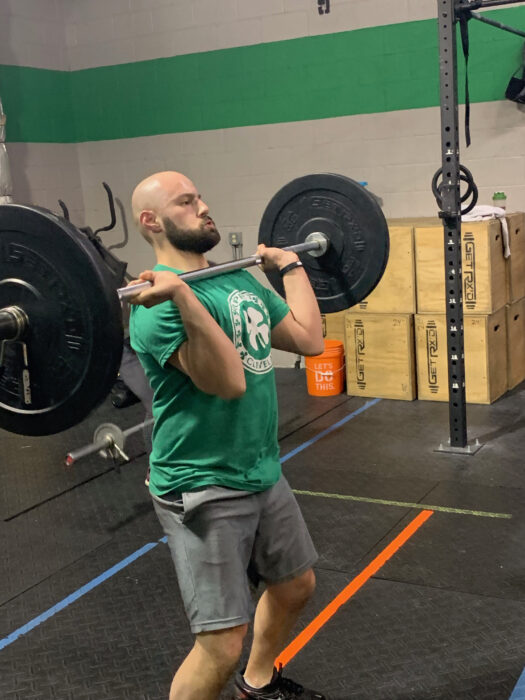Fast and Heavy Isn’t Always Best
When Iron-Oak Fitness first opened, four years ago, we utilized something that no other gyms in the area were doing. We abandoned it, feeling like the odd kid on the block, and earlier this year brought it back because we believe it’s the best way to safely get stronger while improving form and shedding some body fat.
We’re referring to Tempo Training, also known as Time Under Tension (TUT).
As CrossFit and Orange Theory grew around the globe, so too did a million other boutique fitness gyms, all approaching fitness the same way – for the most part. The motto for strength training moved from lifting heavy with lots of rest, to lifting heavy as fast as possible, and cardio followed suite. Move as fast as you can.
While there are benefits to moving fast, it’s not necessarily the safest or the most effective means of getting results. It has a time and place but it should not be daily.
Iron-Oak Fitness roots were grounded in doing things a bit differently using a method that has been proven successful over time, tempo training. The reasons for our die-hard belief in this, as well as why returned to this style after a brief moment of our history, is because it gets results.

We don’t need to be the gym yelling at people to go as fast as they can and as heavy as they can. We intentionally slow things down for our strength training and our members rake in the benefits.
There’s a reason you see so many gym fails floating around the Internet that revolve around CrossFit gyms or other group fitness models who focus solely on speed. It’s because form goes out the window while the ego to be number one goes up. The rise of injury rides on the ego as well.
It’s not hard to throw your body around as fast as you can without proper form. That just doesn’t sit well with us, which is one of the many reasons we abandoned the CrossFit affiliation in two short years. Faster is not always better.
When it comes to resistance training, our workouts force you to listen to your body and do things the proper way. Smooth and steady. If you think doing 100 squats as fast as possible is hard, try doing 10 squats by moving at a 5-second descent, staying at the bottom for a few more, and then slowly rising back to the top. Trust us, it’s killer.
This doesn’t mean our high intensity portions of the workouts won’t put your petal to the metal, but this needs to be strategically placed.
Curious to see what tempo training is all about? Click here to reserve a free trial class.
For the nerds who want to learn more about tempo training, read on…
No one knows for sure where TUT was created but many attribute it to strength coach, and author, Charles Poliquin.
TUT is about timing.
You might see a “prescription” to do a set at 30X0 for example. Tempo prescriptions come in a series of four numbers, each number representing the time (in seconds) in which it should take to complete a stage of a lift.
The First Number:
This number refers to the lowering (the eccentric) phase of a lift. Using a front squat as an example for 30X0, the 3 would refer to three seconds descending to the bottom of a the squat.
The first number always represents the lowering/eccentric phase of a lift, even if the movement begins with the
ascending / concentric part of a lift, like a pull-up.
Confused?
A pull-up starts from the hang and you have to pull your way to the top, right?
With a tempo prescription, you’d actually start your rep from the top. In the example of 30X0, you’d spend three seconds lowering yourself back to the bottom.
The Second Number:
This number refers to the amount of time in the bottom position of a lift, or in the example of a weighted pull-up, at the hang position. This is the phase where the lift transitions from lowering to ascending.
Let’s go back to the front squat example of “30X0.” In this example, the “0” means the athlete should get to the bottom of the squat and immediately begin the ascension back to the top. If, however, this were a “3,” it would require you to stay at the bottom for three full seconds.
The Third Number:
This is the ascending (concentric) phase, the amount of time to get back to the top. If the prescription is an “X,” it just means you should explode to the top. If, however, it were a 3, this would mean three seconds to get back to the top.
The Fourth Number:
The last number represents how long you should pause at the top of a lift. If performing a deadlift where the prescription is “20X2,” you would be expected to pause for two seconds at the hip (the top) before going back down to your next rep.
How to Count:
While this appears to be a no-brainer and not really something worth noting, I’ve found that it’s actually pretty crucial. For whatever reason, people don’t seem to be able to dial in the concept of what one second actually looks like. If I prescribe a 4-second tempo, class members generally complete this in two seconds on a timer. The goal is not to count to four as fast as you can because it’s freaking hard. It should be counted as:
1-one-thousand
2-one-thousand
etc…
If you’re saying the thousands, or Mississippi’s if you prefer, a timer should reflect the same number of seconds. Without fully achieving the prescribed tempo, you’re NOT going to reap the benefits.
Benefits of Tempo Training:
TUT is great for any ability level, beginner to advanced, regardless of goal (weight loss, muscle gain, etc.).
1. Helps Improve Quality of the Movement
Slowing things down allows you to “feel” out how your body is moving. It will quickly enable you to discover what portions of a lift are weakest, which in turns give you an idea of how to better train to get stronger or more efficient in those phases. For a new athlete, this means greater awareness in general. For an experienced athlete, this will in turn allow them to focus training to get to the next level. This also allows for a window to fix form issues because as you go slower, the flaws come out more obvious.
2. Reduced Risk of Injury
This is probably already clear based on what was said in regard to improving quality of the movement. However, slowing things down also eases the stress that’s put on the joints and instead moves the stress to the muscles. It’s much better to let the muscles power the lift versus the joints. Muscles adapt to increased loads far better than joints.
“Connective tissue typically takes longer to strengthen and adapt to the increasing loads, so by slowing down the tempo (time under tension), you can give your connective tissue some rest while still strengthening the surrounding musculature,” said CrossFit coach, USA Weightlifting coach, and co-founder of Kids Helping Kids, C.J. Martin.
3. Improved Strength/Muscle Gains and Fat Loss
One huge benefit for many people is the change in body composition found when utilizing TUT. A study in the journal of Applied Physiology, Nutrition, and Metabolism compared the effect of three different lifting tempos on energy expenditure and excess post-exercise oxygen consumption (EPOC).
The higher the level of EPOC, the higher the metabolism elevates to a degree after exercise. In other words, your body continues to burn calories after working out. Some studies say this can continue for up to 48 hours afterward. This is another reason this is a great pair to Iron-Oak’s high intensity portion of the workouts.
As well, the study shows that when your muscle is under tension for longer periods of time, your energy stores (like creatine phosphate and muscle glycogen) go up and so does the amount of growth hormone released. This is great for both fat burning and muscle building. The study shows that this slower lifting increases protein synthesis too. Another benefit for adding some lean muscle.
According to Martin, by using different tempos, you’ll reach fewer plateaus and more adaptations. This allows “us to shore up weak links by overloading certain areas of movements.”
I love this about TUT because many of our gym’s members seemed to come to an idea on their own that you can only get stronger by lifting heavy all the time and without tempo. Oddly enough, when traditional strength training cycles were removed from our gym and tempo training was reinstated after getting back to our roots, personal records were made when throwing back in the occasional non-tempo lift. In other words, their heavy lifts got heavier by not lifting heavy, and instead, lifting lighter weights at a tempo.
Think about this for a moment.
We all know we do this to try to get heavier deadlifts…we hit the weights hard on the ground, to give us a bit of a cheat, a bit of momentum to move into that next rep. We cheat because, without knowing why, that extra “bounce” shortens the length of the pull.
By using TUT, however, slowing the concentric phase of our deadlift (the lift back to the top), we can strengthen that lower portion of the lift and the end result will be a heavier overall deadlift when not using tempo. Sounds good, right? That’s because it is.
Another aspect to increased strength gains is that when we pause at the top and/or bottom of these lifts, we’re forced to recruit more muscle fibers. “More muscle fiber recruitment,” said Martin, “(particularly more fast-twitch fibers) equals greater strength gains.”
Okay, enough already. I could keep writing on and on about this but the main point is clear here, and in the words of the Beastie Boys, just go “slow and low, that is the tempo.”


